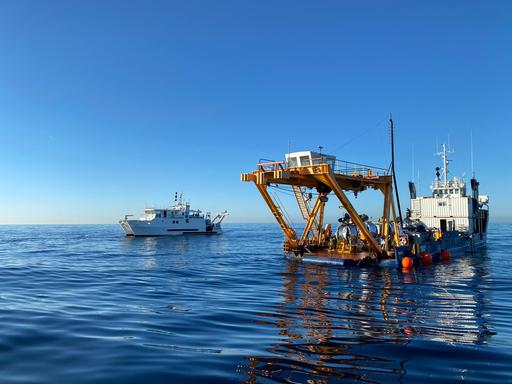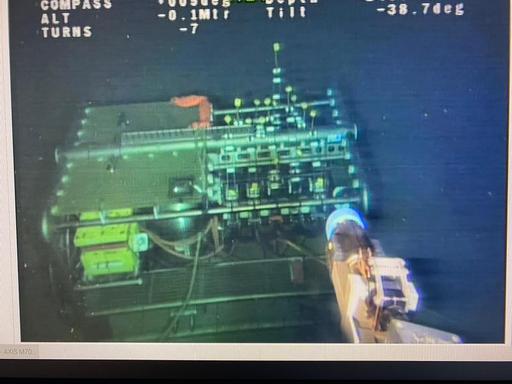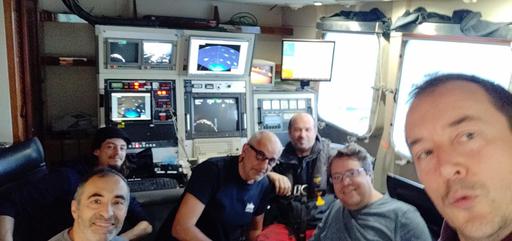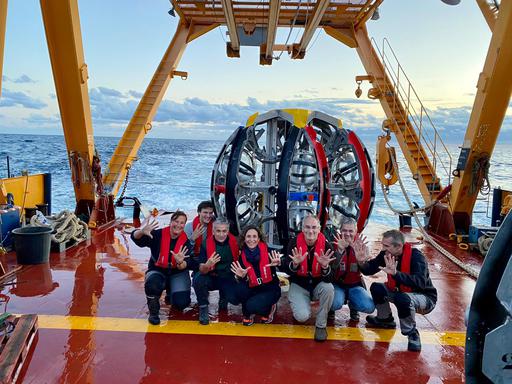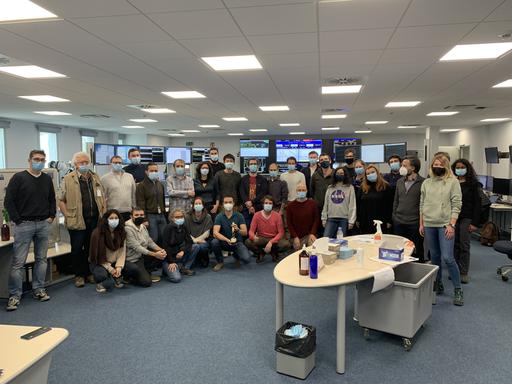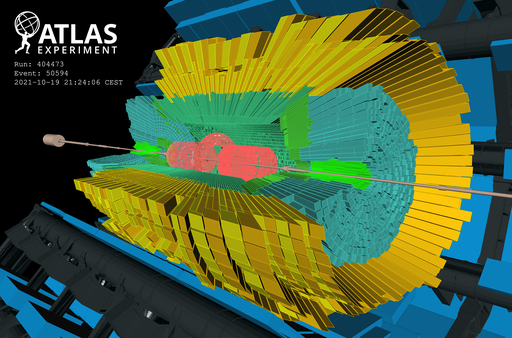End of data collection of the ANTARES neutrino telescope
On Saturday 12 February 2022, after more than 15 years of data collection, the ANTARES detector, the first underwater neutrino telescope ever built, was finally shut down! On that day, the Ifremer submarine Nautile, with Jürgen Brunner on board, dived to the ANTARES site located offshore Toulon at a depth of 2,480 m and began dismantling the detector by disconnecting all the underwater cables linking the detection lines to the main Junction Box. These operations will continue next spring with the successive recovery of all the lines during a multi-day marine campaign involving the Foselev Marine vessel Castor and the Achilles underwater robot operated from the SAAS vessel Janus. Since the deployment of its first line on 14/02/2006 (see pictures of line 1 on Valentin’s day), the ANTARES detector has collected more than 15000 neutrinos and the Collaboration has published more than 90 papers. The ongoing analyses will of course continue for some time to make the most of all the data recorded until the last day. This message is an opportunity to thank all the people of the CPPM who have contributed at one time or another to the definition, construction, operation, exploitation and data analysis of ANTARES, and have thus participated in the success of this magnificent adventure!
Dernière modification: Apr 24, 2023, 9:28:03 AMDark Energy Spectroscopic Instrument (DESI) Creates Largest 3D Map of the Cosmos
The Dark Energy Spectroscopic Instrument (DESI) has capped off the first seven months of its survey run by smashing through all previous records for three-dimensional galaxy surveys, creating the largest and most detailed map of the universe ever. Yet it’s only about 10% of the way through its five-year mission.
DESI has come a long way to reach this point. Originally proposed over a decade ago, construction on the instrument started in 2015. It was installed at the Mayall 4-meter telescope at Kitt Peak National Observatory near Tucson, Arizona. The instrument saw first light in late 2019. Then, during its validation phase, the coronavirus pandemic hit, shutting down the telescope for several months, though some work continued remotely. In December 2020, DESI turned its eyes to the sky again, testing out its hardware and software, and by May 2021 it was ready to start its science survey.
DESI has already cataloged over 7.5 million galaxies and is adding more at a rate of over a million a month. In November 2021 alone, DESI cataloged redshifts from 2.5 million galaxies. By the end of its run in 2026, DESI is expected to have over 35 million galaxies in its catalog, enabling an enormous variety of cosmology and astrophysics research.
But that productivity requires incredibly detailed control over each of the 5000 cutting-edge robots that position optical fibers on the DESI instrument, ensuring their positions are accurate to within 10 microns, less than the thickness of a human hair. That level of accuracy is needed to accomplish the primary task of the survey: collecting detailed color spectrum images of millions of galaxies across more than a third of the entire sky. With a 3D map of the cosmos in hand, physicists can chart clusters and superclusters of galaxies, as well as cosmic voids. Those structures carry echoes of their initial formation, when they were just ripples in the infant cosmos. By teasing out those echoes, physicists can use DESI’s data to determine the expansion history of the universe.
Understanding the expansion history is crucial, with nothing less than the fate of the entire universe at stake. Today, about 70% of the content of the universe is dark energy, a mysterious form of energy driving the expansion of the universe ever faster. Dark energy will ultimately determine the destiny of the universe: will it expand forever? Will it collapse onto itself again, in a Big Bang in reverse? Or will it rip itself apart? Answering these questions means learning more about how dark energy has behaved in the past – and that’s exactly what DESI is designed to do. And by comparing the expansion history with the growth history, cosmologists can check whether Einstein’s theory of general relativity holds over these immense spans of space and time.
DESI is supported by the d’A*Midex and OCEVU Labex, then by the Institut Physique de l’Univers (IPhU). Several AMU laboratories (Observatoire de Haute Provence (OHP), Centre de Physique des Particules de Marseille (CPPM) and Laboratoire d'Astrophysique de Marseille (LAM)) have participated since 2014 in the development of the 10 spectrographs of the DESI instrument, in partnership with the local company Winlight, and now in the processing and analysis of the collection of data collected by the instrument.
Dernière modification: Apr 24, 2023, 9:28:03 AMLHC - New LHCb data acquisition system tested for the first time
During the LHC pilot tests at the end of October, the new LHCb data acquisition system prepared for Run 3 was tested for the first time. This system no longer uses a hardware trigger, so the 40 Tbit/s data rate will be transmitted entirely to ~200 servers, also hosting graphics cards on which the first real-time data analysis and selection of data in real time.
The LHCb team at CPPM is very active in the data acquisition system, having on the one hand developed the data acquisition cards (PCIe40) that receive the data and transmit them to the servers, and to the servers, and also playing a major role in the trigger on GPUs.
At the end of October, the PCIe40 cards were successfully operated for the first time with real data from the three systems already installed: the calorimeters, the muon detector and the RICHs.
During these tests, the trigger was also integrated and selected proton collisions for the first time using the information from the calorimeter. Not all graphics cards were installed in the servers yet, but the software was tested on the server CPUs and some of the available graphics cards in October.
This is a major step towards the commissioning of the complete system.
Dernière modification: Apr 24, 2023, 9:28:03 AMAdditional detection units for the KM3NeT/ORCA underwater neutrino detector
The underwater neutrino detector KM3NeT/ORCA investigates the limits of Matter and of the Universe at a depth of 2450 metres in the Mediterranean Sea. It allows to search for cosmic neutrinos and to study their fundamental properties. This detector is being installed and will eventually feature a hundred detection lines with sensors that are very sensitive to the light emitted by muons, particles that are the result of neutrinos, real cosmic messengers. On November 22, four new lines were added to the six existing ones and are working perfectly. Thus, more data will be studied by the scientific teams.
On November 19, the KM3NeT team boarded on Castor, a Foselev Marine vessel, with the detection lines. The Janus, a SAAS/Comex Marine oceanographic research and underwater intervention vessel, was also on site, at about 40 km offshore La Seyne-sur-Mer. The operation at sea was a large one, as seven lines were to be deployed, but the sea state rapidly deteriorated and the operation had to be shortened. Nevertheless, four lines were installed on the seabed and connected to the junction box, thanks to an ROV (Remotely Operated Underwater Vehicle). The junction box is a real masterpiece of the installation because it is from this device that is also connected the electro-optical cable of about 40 kilometres through which all the data transit to the control station on land and will be analysed by the scientists of the KM3NeT international collaboration.
Read more:
-
Integration of the light sensors that make up a detection unit: https://www.cppm.in2p3.fr/~coyle/LomLoadingORCAtimes2.mp4
-
Deployment of a detection unit: https://bit.ly/3HPtVFq
-
KM3NeT project: https://www.km3net.org/
-
ANTARES project: https://antares.in2p3.fr/
-
Contacts : Paschal Coyle, spokesperson for the KM3NeT collaboration ; Vincent Bertin, head of the CPPM Neutrinos team
Protons are back in the LHC!
After more than two years of maintenance and upgrades to the collider and detectors, pilot tests of the LHC are underway.
Splash events (particle flows from the interaction between the beams and a collimator located upstream of the detector) have been recorded, notably by the ATLAS and LHCb experiments. The first proton frictions at the LHC injection energy (450 GeV per beam) in stable mode took place at the end of October. This allowed the two detectors to record their first data and to validate their correct operation.
The next step is the start of Run 3 in March 2022, when the LHC will increase its energy in the center of mass from 13 to 13.6 TeV.
The LHC has just started the circulation of the beams at the injection energy (2x450 GeV) in stable mode and ATLAS records these data and in particular with its liquid argon calorimeter (LAr) which has had a major update in which the CPPM team is very active. The LAr system has just transmitted for the first time data with this new readout system in its fully updated configuration and in particular to the new first level calorimetric triggering system. This is a major step towards Run 3 which will start in spring 2022.
Read more:
-
https://www.cppm.in2p3.fr/web/en/research/particle_physics/index.html#ATLAS
-
https://www.cppm.in2p3.fr/web/en/research/particle_physics/index.html#LHCb
-
Contacts: Marlon Barbero, head of the ATLAS team ; Olivier Leroy, head of the LHCb team
